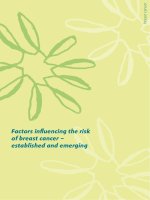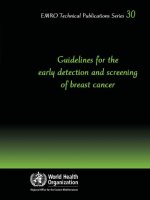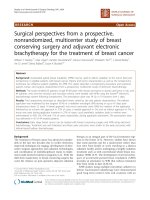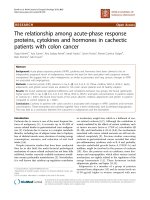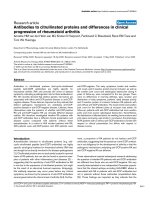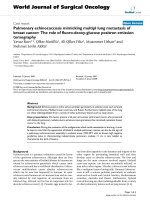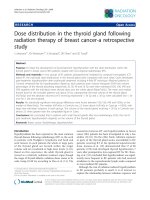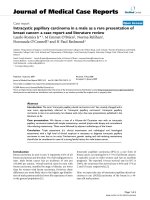the role of ikkalpha, ikkbeta and nf-kappab in the progression of breast cancer
Bạn đang xem bản rút gọn của tài liệu. Xem và tải ngay bản đầy đủ của tài liệu tại đây (5.52 MB, 233 trang )
Glasgow Theses Service
Bennett, Lindsay (2014) The role of IKKalpha, IKKbeta and NF-kappaB
in the progression of breast cancer. PhD thesis.
Copyright and moral rights for this thesis are retained by the author
A copy can be downloaded for personal non-commercial research or
study, without prior permission or charge
This thesis cannot be reproduced or quoted extensively from without first
obtaining permission in writing from the Author
The content must not be changed in any way or sold commercially in any
format or medium without the formal permission of the Author
When referring to this work, full bibliographic details including the
author, title, awarding institution and date of the thesis must be given.
The role of IKKalpha, IKKbeta
and NF-kappaB in the
progression of breast cancer
Lindsay Bennett
BSc(Hons), MSc
Submitted in fulfillment of the requirements
for the degree of PhD
Institute of Cancer Sciences
College of Medical, Veterinary and Life Sciences
University of Glasgow
July 2014
The work presented in this thesis was performed entirely by the author except as
acknowledged. This thesis has not been previously submitted for a degree or diploma at
this or any other institution.
Lindsay Bennett
July 2014
3
Acknowledgements
Firstly I would like to express my gratitude to my supervisor, Dr Joanne Edwards, for the
opportunity to be involved in this project and for her continued help and guidance. I could
not have asked for a more encouraging supervisor and I have thoroughly enjoyed my time
in her lab.
Thank you also to the members of Dr Edwards’ team, especially Dr Pamela McCall for all
of her assistance and advice. Also thanks to Dr Zahra Mohammed, and her supervisor
Professor Donald McMillan, for undertaking studies that allowed correlation of the
markers examined in my thesis with this data. Thanks to members of Professor Paul
Shiels’ team, in particular Mr Alan MacIntyre, tissue culture master, and Dr Liane
McGlynn for sharing her knowledge. I am also grateful to Dr Elizabeth Mallon, Ms Julie
Doughty and Professor Paul Horgan for their support.
Thanks too to Dr Andrew Paul, my supervisor at the University of Strathclyde, for offering
his advice and for allowing me to spend 6 months in his lab, and to the members of his
team and others in SIPBS who helped me during my time there, particularly Katy and
Emma.
Many thanks to all my family and friends for being there when I needed them and
providing much needed distraction! A special thank you to Mark for his vital support and
patience throughout. Last, but by no means least, I would like to thank my mum and dad.
Their love and support, moral and financial, during my PhD (and the 23 years previous!)
has been brilliant. Their encouragement has always driven me and I cannot thank them
enough for everything they do for me.
To everyone who has helped me in any way throughout my PhD, thank you all.
4
5
Summary
Breast cancer is the most common female cancer in the UK and, despite earlier detection
and improved treatments, remains the second most common cause of cancer death in
women. Although therapies exist for breast cancer, including endocrine therapy for
oestrogen receptor (ER) positive tumours, resistance to current treatment remains a major
problem. The molecular mechanisms of endocrine resistance have yet to be fully
elucidated and in order to improve treatment for patients this needs to be addressed.
Clinically breast cancer presents as several distinct diseases with different outcomes and
molecular profiles. Over the past decade, through the use of molecular profiling, the
number of different subtypes of breast cancer has grown and understanding the pathways
driving each subtype may allow a stratified approach to therapy, allowing patients to
receive the treatment which will be of most benefit.
The Nuclear Factor kappa B (NF-κB) pathways regulate the transcription of a wide range
of genes involved in the immune response, inflammation, proliferation and apoptosis.
Many of these processes are hallmarks of cancer and NF-κB has been hypothesised to have
a role in tumorigenesis. The aim of the current study was to investigate the role of both
NF-κB pathways in the pathogenesis and recurrence of breast cancer.
Immunohistochemistry was employed to assess key components of the canonical and non-
canonical NF-κB pathways on a tissue microarray (TMA) of 544 patients with full clinical
follow up and clinical information including ER status, subtype, necrosis, apoptosis and
angiogenesis. Nuclear expression of p65 phosphorylated at serine 536 was associated with
angiogenesis and shorter recurrence free interval. Cytoplasmic expression of IKKα was
associated with cell death (apoptosis and necrosis) and a shorter recurrence free interval
was also observed for those with high expression. These observations between phospho-
p65/IKKα and recurrence free interval, when subdivided by ER status, remained
significant in ER positive tumours but were negated in ER negative tumours. When split
further into subtype, a diverging role for each was observed with phospho-p65 associating
with recurrence in luminal B tumours and IKKα with luminal A tumours. Other members
of the NF-κB pathways (p65, IKKβ, NIK and RelB) were not associated with recurrence
free interval. When these results were tested in an independent cohort, IKKα remained
significant on recurrence free interval and breast cancer specific survival in ER positive
tumours however phospho-p65 was only marginally associated with breast cancer specific
survival. Variability of phospho-p65 is a major issue in IHC studies and therefore an
alternative marker of the canonical NF-κB pathway is required. Analysis of expression in
6
this second cohort also revealed that high levels of IKKα in the cytoplasm were associated
with recurrence on tamoxifen. This marker may therefore be able to be employed as a
diagnostic tool to predict patients who are likely to display endocrine resistance and may
represent a therapeutic strategy in combination with endocrine therapy, or for patients after
endocrine resistance has occurred.
Further examination of the pathways in breast cancer cell lines also demonstrated a
difference between ER positive and ER negative breast cancer. In ER negative MDA-MB-
231 cells phosphorylation of p65 (from the canonical NF-κB pathway) and
phosphorylation of p100 (from the non-canonical NF-κB pathway) was apparent even in
untreated control cells, suggesting constitutive activation. Expression was however found
to be inducible in ER positive MCF7 cells.
In order to investigate whether kinases involved in activation of each pathway, IKKβ in the
canonical pathway and IKKα in the non-canonical NF-κB pathway, had potential as targets
in breast cancer, we examined the phenotypic impact of silencing their expression in breast
cancer cell lines. Silencing IKKβ induced apoptosis and decreased cell viability in both
MCF7 and MDA-MB-231 cells but reduction in expression of IKKα only impacted on cell
viability and apoptosis in ER positive MCF7 cells. This data, consistent with results from
the clinical specimens, has therefore revealed that inhibitors of IKKα are likely to be most
beneficial in the treatment of ER positive tumours.
These results suggest that the NF-κB pathways are associated with recurrence in patients
with ER positive tumours with each pathway possibly associating with recurrence in
different subtypes. Additional studies in a larger cohort, including patients receiving
aromatase inhibitors are required, accompanied by extensive mechanistic studies to further
explore the roles of IKKα and IKKβ in breast cancer. These observations highlight that
different subgroups of breast cancer may have different signalling pathways driving
progression and therefore patients are likely to benefit from different therapeutic strategies.
7
Publications and presentations
Publications relating to this thesis
Bennett, L., McCall, P., Mallon, E.A., Doughty, J.C., Horgan, P.G., Paul, A., and
Edwards, J. (2014) High expression of the NF-κB pathways are associated with the
progression of ER positive breast cancer
(In preparation).
Poster presentations
Bennett, L., Mohammed, Z., Orange, C., Horgan, P.G., Doughty, J.C., Mallon, E.A., and
Edwards, J. (2012) Nuclear expression of activated NF-κB is associated with increased
recurrence in breast cancer patients.
EACR-22, Barcelona, July 2012
Published abstract: EJC. Pages S183-S184.
Bennett, L., Orange, C., Mallon, E.A., Doughty, J.C., Horgan, P.G., Paul, A., and
Edwards, J. (2013) The canonical and non-canonical NF-κB pathways are associated with
increased recurrence in different subtypes of ER positive breast cancer.
104
th
AACR Annual Meeting, Washington, April 2013
Bennett, L., Orange, C., Mallon, E.A., Doughty, J.C., Horgan, P.G., Paul, A., and
Edwards, J. (2013) The role of NF-κB in breast cancer progression.
1
st
WeCan Breast cancer symposium, Glasgow, March 2013
Doughty, J.C., Bennett, L., Mallon, E.A., Horgan, P.G., and Edwards, J. (2013)
Association of the canonical NF-κB pathway with clinical outcome measures in ER
negative breast cancer.
2013 ASCO Annual Meeting, Chicago, June 2013.
Published abstract: J Clin Oncol 31, Suppl Abstr 588.
Oral presentations
Bennett, L., Mallon, E.A., Doughty, J.C., Horgan, P.G., Paul, A., and Edwards, J. (2012)
The canonical and non-canonical NF-κB pathways have diverging roles in ER positive
breast cancer.
British Breast Group, Glasgow, January 2013.
8
Contents
LIST OF FIGURES 12
LIST OF TABLES 14
ABBREVIATIONS 15
CHAPTER 1: INTRODUCTION 17
1.1 Breast cancer epidemiology, pathology and prognostic factors 18
1.1.1 Breast cancer incidence, mortality and survival 18
1.1.2 Breast cancer risk factors 19
1.1.3 Breast cancer pathology 22
1.1.4 Pathological prognostic markers 24
1.1.5 Pathological grading systems 25
1.1.6 Molecular prognostic factors 27
1.1.7 Breast cancer subtypes 28
1.1.8 Tests for molecular profile of breast cancer 29
1.2 Treatment of breast cancer 31
1.2.1 Surgery 31
1.2.2 Chemotherapy 32
1.2.3 Radiotherapy 32
1.2.4 Targeted therapy 33
1.2.5 Hormonal therapy 34
1.2.6 Endocrine resistance 37
1.2.7 Summary on breast cancer treatment 39
1.3 The NF-κB pathways 40
1.3.1 Cell growth mechanisms and signalling pathways in cancer 40
1.3.2 Members of the NF-κB family 41
1.3.3 The canonical NF-κB pathway 42
1.3.4 The non-canonical NF-κB pathway 44
1.3.5 Functions of the IKKs 46
1.3.6 NF-κB/IKKs and cancer 48
1.3.7 NF-κB/IKKs and breast cancer 49
1.4 Research aims and hypothesis 52
CHAPTER 2: MATERIALS AND METHODS 53
2.1 Tissue studies 54
2.1.1 Antibody validation 54
2.1.2 Patient TMA 55
2.1.3 Immunohistochemistry 59
2.1.4 TUNEL assay 62
2.1.5 Scoring of IHC 63
2.1.6 Statistical Analysis 64
2.2.1 Culturing of breast cancer cell lines 65
2.2.2 Stimulation of the NF-ĸB pathways in breast cancer cells 65
2.2.3 siRNA knockdown of IKKα and IKKβ in breast cancer cells 66
2.2.4 DN-IKKβ adenovirus infection in breast cancer cells 69
2.3 Western blotting 70
2.3.1 Lysis of protein 70
2.3.2 SDS-Polyacrylamide Gel Electrophoresis (SDS-PAGE) 70
9
2.3.3 Protein transfer 71
2.3.4 Blocking, staining and visualisation 71
2.3.5 Stripping membrane 72
2.3.6 Quantification of expression levels 72
2.4 Cell pellets 73
2.4.1 Preparation of cell pellets 73
2.4.2 Cutting cell pellets 73
2.4.3 IHC of cell pellets 73
2.5 Gene expression profiling 74
2.5.3 Quantitative Real Time-PCR 75
2.6 Phenotypic assays 76
2.6.1 Cell death assay 76
2.6.2 WST-1 viability assay 76
2.6.6 Statistical analysis of WST-1/apoptosis assays 77
2.6.3 Cell viability via the xCELLigence 77
CHAPTER 3: ASSESSMENT OF PROLIFERATION, APOPTOSIS AND
MOLECULAR SUBTYPES IN BREAST CANCER CLINICAL SPECIMENS BY
IMMUNOHISTOCHEMISTRY 78
3.1 Introduction 79
3.2 Clinico-pathological characteristics of the patient cohorts 79
3.2.1 1800-Bre-TMA 79
3.2.2 ST-Bre-TMA 81
3.3 Ki67 as a marker of proliferation 82
3.3.1 Ki67 in the 1800-Bre-TMA cohort 82
3.3.2 Ki67 in the ST-Bre-TMA cohort 84
3.4 Categorising tumours into subtypes using IHC markers 86
3.4.1 Subtypes in the 1800-Bre-TMA cohort 86
3.4.2 Subtypes in the ST-Bre-TMA cohort 88
3.5 TUNEL as a marker of apoptosis 89
3.5.1 Apoptosis in the 1800-Bre-TMA cohort 89
3.5.2 Apoptosis in the ST-Bre-TMA cohort 92
3.6 Discussion 94
CHAPTER 4: EXPRESSION OF MEMBERS OF THE NF-κB PATHWAYS IN
BREAST CANCER CLINICAL SPECIMENS 100
4.1 Introduction 101
4.2 Antibody validation of members of the canonical pathway 101
4.2.1 Validation of anti-IKKβ antibody 101
4.2.2 Validation of antibodies detecting the p65 subunit 102
4.3 Expression and clinical outcome of members of the canonical pathway 104
4.3.1 Expression of IKKβ and clinical outcome 104
4.3.2 Expression of p65 and clinical outcome 106
4.3.3 Phosphorylation of p65 and clinical outcome 109
4.3.4 Expression of phosphorylated p65 versus p65 NLS and clinical outcome 112
4.3.5 Expression of phospho-p65 in different subgroups of breast cancer and
clinical outcome 113
10
4.4 Antibody validation of members of the non-canonical pathway 117
4.4.1 Validation of anti-NIK antibody 117
4.4.2 Validation of anti-RelB antibody 118
4.4.3 Validation of anti-IKKα antibody 119
4.5 Expression and clinical outcome of members of the non-canonical pathway 120
4.5.1 Expression of NIK and clinical outcome 120
4.5.2 Expression of RelB and clinical outcome 122
4.5.3 Expression of IKKα and clinical outcome 124
4.6 Discussion 131
CHAPTER 5: EXPRESSION OF PHOSPHO-P65 AND IKKα IN AN
INDEPENDENT COHORT OF ER POSITIVE BREAST CANCERS 135
5.1 Introduction 136
5.2 Expression of phosphorylated p65 in the ST-Bre-TMA 136
5.2.2 Nuclear expression of phospho-p65 in the ST-Bre-TMA and clinical outcome 137
5.2.3 Association of phospho-p65 nuclear expression with clinico-pathological
characteristics of the ST-Bre-TMA 139
5.2.4 Nuclear expression of phospho-p65 in the ST-Bre-TMA and clinical outcome in
different luminal subtypes 140
5.3 Expression of IKKα in the ST-Bre-TMA 142
5.3.1 Cytoplasmic expression of IKKα in the ST-Bre-TMA 142
5.3.2 Cytoplasmic expression of IKKα in the ST-Bre-TMA and clinical outcome 143
5.3.3 Association of IKKα cytoplasmic expression with clinico-pathological characteristics
of the ST-Bre-TMA 145
5.4 Discussion 148
CHAPTER 6: EXPRESSION OF COMPONENTS OF THE NF-κB
PATHWAYS IN BREAST CANCER CELL LINES 151
6.1 Introduction 152
6.2 Activation of the canonical NF-κB pathway in breast cancer cell lines 152
6.2.1 Activation of the canonical NF-κB pathway in MCF7 and MDA-MB-231 cells 153
6.2.2 TNFα exposure and expression of components of the canonical NF-κB pathway in
MCF7 cells 155
6.2.3 TNFα exposure and expression of components of the canonical NF-κB pathway in
MDA-MB-231 cells 157
6.3 Activation of the non-canonical NF-κB pathway in breast cancer cell lines 160
6.3.1 Activation of the non-canonical NF-κB pathway in MCF7 and MDA-MB-231 cells 160
6.3.2 Lymphotoxin exposure and expression of components of the non-canonical NF-κB
pathway in MCF7 cells 162
6.4 Inhibition of IKKα and IKKβ 165
6.4.1 siRNA silencing of IKKα and IKKβ in MCF7 cells 165
6.4.2 siRNA silencing of IKKα and IKKβ in MDA-MB-231 cells 165
6.4.3 Infection with Adv.DN-IKKβ in MCF7 and MDA-MB-231 cells 168
6.5 Effect of siRNA silencing of IKKα and IKKβ upon gene expression in MCF7 cells. 170
6.6 Discussion 173
11
CHAPTER 7: PHENOTYPIC IMPACT OF STIMULATING OR INHIBITING THE
NF-κB PATHWAYS IN BREAST CANCER CELL LINES 177
7.1 Introduction 178
7.2 Impact of stimulation of the canonical and non-canonical pathways on cell growth
and viability 178
7.2.1 Assessment of apoptosis in breast cancer cells following stimulation of the NF-κB
pathways 178
7.2.2 Assessment of viability in breast cancer cells following stimulation of the NF-κB
pathways by WST-1 183
7.2.3 Assessment of cell viability in breast cancer cells following stimulation of the NF-κB
pathways using xCELLigence 188
7.3 Impact of silencing the IKKs on cell growth and viability 191
7.3.2 Assessment of apoptosis in breast cancer cells following silencing of IKKα and IKKβ 191
7.3.1 Assessment of cell viability in breast cancer cells following silencing of IKKα and IKKβ
using WST-1 194
7.3.3 Assessment of cell viability in breast cancer cells following silencing of IKKα and IKKβ
using xCELLigence 197
7.4 Discussion 199
CHAPTER 8: GENERAL DISCUSSION 203
REFERENCES 212
12
List of Figures
Figure 1.1: Incidence and mortality rates of breast cancer in women in the UK
over time 18
Figure 1.2: Anatomical structure of the breast. 22
Figure 1.3: Histopathology of normal breast tissue and invasive carcinoma 23
Figure 1.4: Mechanisms of action of different endocrine therapies 36
Figure 1.5: The canonical NF-κB pathway 43
Figure 1.6: The non-canonical NF-κB pathway 45
Figure 2.1: Assembly of the sandwich for western blot transfer 71
Figure 3.1: Ki67 and outcome in the 1800-Bre-TMA 83
Figure 3.2: Expression of Ki67 in the ST-Bre-TMA cohort 84
Figure 3.3: Ki67 and clinical outcome in the ST-Bre-TMA cohort 85
Figure 3.4: Breast cancer subtypes and clinical outcome in the 1800-Bre-TMA cohort 87
Figure 3.5: Breast cancer subtypes and clinical outcome in the ST-Bre-TMA cohort 88
Figure 3.6: Automated scoring of TUNEL using the Slidepath Tissue Image
Analysis nuclear algorithm 90
Figure 3.7: Expression of TUNEL in the 1800-Bre-TMA 90
Figure 3.9: Expression of TUNEL in the ST-Bre-TMA 92
Figure 3.10: Apoptosis and clinical outcome in the ST-Bre-TMA cohort. 93
Figure 4.1: Validation of the anti-IKKβ antibody. 102
Figure 4.2: Validation of the anti-p65, anti-phospho-p65 and anti-p65-NLS
antibodies. 103
Figure 4.3: Expression of IKKβ and clinical outcome in the 1800-Bre-TMA 105
Figure 4.4: Expression of p65 and clinical outcome in the 1800-Bre-TMA 107
Figure 4.5: Correlation in expression between members of the canonical
pathway 108
Figure 4.6: Expression of phospho-65 and clinical outcome in the 1800-Bre-TMA 110
Figure 4.7: Comparison of p65 NLS and phospho-p65 nuclear expression on
clinical outcome in the 1800-Bre-TMA. 112
Figure 4.8: Nuclear expression of phospho-p65 is associated with recurrence free
interval in ER positive patients 113
Figure 4.9: Nuclear expression of phospho-p65 and recurrence free interval in
different subtypes of breast cancer 114
Figure 4.10: Nuclear expression of phospho-p65 and recurrence free interval in
luminal B patients 115
Figure 4.11: Nuclear expression of phospho-p65 and recurrence free interval in
the first 5 years of tamoxifen treatment 116
Figure 4.12: Validation of the anti-NIK antibody 117
Figure 4.13: Validation of the anti-RelB antibody 118
Figure 4.14: Validation of the anti-IKKα antibody 119
Figure 4.15: Expression of NIK and clinical outcome in the 1800-Bre-TMA. 121
Figure 4.16: Expression of RelB and clinical outcome in the 1800-Bre-TMA. 123
Figure 4.17: Expression of IKKα and clinical outcome in the 1800-Bre-TMA. 125
Figure 4.18: Correlation in expression between members of the non-canonical
pathway 127
Figure 4.19: Cytoplasmic expression of IKKα is associated with recurrence free
interval in ER positive patients 128
Figure 4.20: Cytoplasmic expression of IKKα and recurrence free interval in
different breast cancer subtypes 129
Figure 4.21: Cytoplasmic expression of IKKα is associated with recurrence on
tamoxifen in luminal A patients 130
13
Figure 5.1: Nuclear expression of phospho-p65 in the ST-Bre-TMA. 137
Figure 5.2: Nuclear expression of phospho-p65 and clinical outcome in the
ST-Bre-TMA. 138
Figure 5.5: Cytoplasmic expression of IKKα in the ST-Bre-TMA 143
Figure 5.6: Cytoplasmic expression of IKKα and clinical outcome in the ST-Bre-TMA. 144
Figure 5.7: Cytoplasmic expression of IKKα and breast cancer specific survival in
luminal subtypes in the ST-Bre-TMA 146
Figure 5.8: Cytoplasmic expression of IKKα and clinical outcome in luminal subtypes
in the ST-Bre-TMA 147
Figure 6.1: Expression of members of the canonical NF-κB pathway in MCF7 and
MDA-MB-231 breast cancer cell lines at following TNFα or IL-1β
exposure. 154
Figure 6.2: Expression of members of the canonical NF-κB pathway in MCF7 breast
cancer cells following TNFα exposure. 156
Figure 6.3: Expression of members of the canonical NF-κB pathway in MDA-MB-231
breast cancer cells following TNFα stimulation. 158
Figure 6.4: Expression of the p65 subunit in MCF7 cell pellets following TNFα
stimulation 159
Figure 6.5: Expression of members of the non-canonical NF-κB pathway in MCF7 and
MDA-MB-231 breast cancer cell lines following TNFα, IL-1 RANK-L or
lymphotoxin exposure 161
Figure 6.6: Expression of members of the non-canonical NF-κB pathway in MCF7
breast cancer cell lines following lymphotoxin exposure 163
Figure 6.7: Expression of members of the non-canonical NF-κB pathway in
MDA-MB-231 breast cancer cell lines following lymphotoxin exposure 164
Figure 6.8: Expression of IKKα and IKKβ after siRNA transfection in MCF7 cells 166
Figure 6.9: Expression of IKKα and IKKβ after siRNA transfection in MDA-MB-231
cells. 167
Figure 6.10: Expression of IKKβ in MCF7 and MDA-MB-231 cells infected with
Adv.DN-IKKβ 169
Figure 6.11: Expression of IKKα and IKKβ after siRNA transfection in MCF7 cells 172
Figure 7.1: Apoptosis in MCF7 cells following stimulation of the canonical and
non-canonical NF-κB pathways 180
Figure 7.2: Apoptosis in MDA-MB-231 cells following stimulation of the canonical
and non-canonical NF-κB pathways 182
Figure 7.3: Cell viability, assessed by WST-1, in MCF7 cells following stimulation
of the canonical and non-canonical NF-κB pathways. 185
Figure 7.4: Cell viability, assessed by WST-1, in MDA-MB-231 cells following
stimulation of the canonical and non-canonical NF-κB pathways. 187
Figure 7.5: Cell viability in MCF7 cells following stimulation of the canonical and
non-canonical NF-κB pathways. 189
Figure 7.6: Cell viability in MDA-MB-231 cells following stimulation of the canonical
and non-canonical NF-κB pathways 190
Figure 7.7: Apoptosis in MCF7 cells following silencing of IKKα or IKKβ 192
Figure 7.8: Apoptosis in MDA-MB-231 cells following silencing of IKKα or IKKβ. 193
Figure 7.9: Cell viability, assessed by WST-1, in MCF7 cells following silencing of
IKKα or IKKβ 195
Figure 7.10: Cell viability, assessed by WST-1, in MDA-MB-231 cells following
silencing of IKKα or IKKβ. 196
Figure 7.11: Cell viability, measured using xCELLigence, in breast cancer cell lines
following silencing of IKKα or IKKβ. 198
14
List of Tables
Table 1.1: Survival rates of breast cancer in Scotland by age range 19
Table 1.2: TNM staging of breast cancer 25
Table 1.3: Subtypes of breast cancer based on routine IHC markers 30
Table 1.4: Effective therapies for the different breast cancer subtypes 39
Table 2.1: Antibody validation 58
Table 2.3: Antibody optimal conditions 61
Table 2.4: siRNA information 67
Table 2.5: siRNA/Lipofectamine® dilution volumes for each size of plate 68
Table 2.6: Antibodies used for western blot and optimal conditions 72
Table 2.7: Information on Gene expression assays 75
Table 3.1: Clinico-pathological characteristics of the 1800-Bre-TMA cohort of breast
cancer patients 80
Table 3.2: Clinico-pathological characteristics of the ST-Bre-TMA cohort of breast
cancer patients 81
Table 3.3: Subtyping of the 1800-Bre-TMA cohort using 4 IHC markers 86
Table 3.4: Subtyping of the ST-Bre-TMA cohort into different luminal subtypes
using Ki67 and HER2 89
Table 4.1: Association of nuclear phospho-p65 with clinico-pathological characteristics
of the 1800-Bre-TMA cohort 111
Table 4.2: Association of cytoplasmic IKKα with clinico-pathological characteristics
of the 1800-Bre-TMA cohort 126
Table 5.1: Association of nuclear phospho-p65 with clinico-pathological characteristics
of the ST-Bre-TMA cohort 139
Table 5.2: Association of cytoplasmic IKKα with clinico-pathological characteristics
of the ST-Bre-TMA cohort 145
15
Abbreviations
AI Aromatase inhibitors
AIB1 Amplified in breast cancer 1
BRCA Breast Cancer genes
CDK Cyclin dependent kinase
CRLF1 Chemokine receptor-like factor 1
CXCL10 Chemokine CXC ligand 10
DAB 3,3'-diaminobenzidine
DMEM Dulbecco's Modified Eagle's Medium
DN Dominant negative
EDTA Ethylenediaminetetraacetic acid
EGFR Epidermal growth factor receptor
ELISA Enzyme-linked immunosorbent assay
ER Oestrogen receptor
ERE Oestrogen response elements
FFPE Formalin-fixed paraffin-embedded
HER2 Human epidermal growth factor receptor 2
HR Hazard ratio
HRP Horseradish peroxidase
HRT Hormone replacement therapy
IAP Inhibitor of apoptosis
ICAM Intracellular adhesion molecule
ICCC Interclass correlation coefficient
IGFR-1 Insulin-like growth factor receptor 1
IHC Immunohistochemistry
IKK IκB kinase
IL-1β Interleukin-1 beta
IQR Interquartile range
IκB Inhibitor of κB
LTx Lymphotoxin
MAPK Mitogen activated protein kinase
mTOR Mammalian target of rapamycin
NCOR2 Nuclear corepressor 2
NEMO NF-κB essential modulator
NES Nuclear export sequence
16
NF-κB Nuclear Factor kappa B
NIK NF-κB-Inducing Kinase
NLS Nuclear localisation signal
NPI Nottingham Prognostic Index
NT Non-targeting siRNA
PCR Polymerase chain reaction
Pfu Plaque forming units
PgR Progesterone receptor
Phospho-p65 Phosphorylation of p65 at serine 536
PI3K Phosphoinositide 3-kinase
qPCR Quantitative real time PCR
SDS-PAGE Sodium dodecyl sulphate - polyacrylamide gel electrophoresis
SERD Selective oestrogen receptor degraders
SERM Selective oestrogen receptor modulators
SIGN Scottish Intercollegiate Guidelines Network
siRNA Small interfering RNA
SMRT Silencing mediator for retinoid or thyroid-hormone receptors
STWS Scott's tap water substitute
T-DM1 Trastuzumab emtansine
TAD Transactivation domain
TBS Tris buffer saline
TEAM Tamoxifen Exemestane Adjuvant Multinational trial
TMA Tissue microarray
TNBC Triple negative breast cancer
TNFα Tumor necrosis factor α
TNM Tumour size, lymph Node involvement, Metastasis
TUNEL Terminal deoxynucleotidyl transferase dUTP nick end labeling
uPA Urokinase-type plasminogen activator
VCAM Vascular cell adhesion molecule
WST-1 Water-soluble tetrazolium salt 1
17
Chapter 1:
Introduction
18
1.1 Breast cancer epidemiology, pathology and prognostic factors
1.1.1 Breast cancer incidence, mortality and survival
Breast cancer is the most common female cancer in the UK with more than 49,500 women
diagnosed in 2010 [1]. The number of cases increases by around 1% each year but a peak was
seen around 1988 after the introduction of the screening programme due to the detection of
undiagnosed cancers (Figure 1.1A). The aim of the breast screening programme is to reduce
mortality rates by earlier detection via mammography before any symptoms are apparent.
Although earlier detection and improved treatments has resulted in a decrease in the number
of deaths (Figure 1.1B) breast cancer still remains the second most common cause of cancer
death in women in the UK with nearly 12,000 deaths attributed in 2010 [2].
Figure 1.1: Incidence and mortality rates of breast cancer in women in the UK over
time. A: Incidence rates per 100,000 women from 1975-2010 [1]. B: Mortality rates per
100,000 women, from 1971 to 2011 [2]. The arrow has been added to indicate the
introduction of the screening programme in 1988.
150
120
90
60
30
0
1975 1980 1985 1990 1995 2000 2005 2010
Year of diagnosis
1971 1975 1980 1985 1990 1995 2000 2005 2011
Year of death
Rate per 100,000
50
40
30
20
10
0
Rate per 100,000
Mortality in women in the UK from 1971-2011
Incidence in women in the UK from 1975-2010
150
120
90
60
30
0
19
Breast cancer has, however, one of the highest survival rates of the most common cancers in
the UK. In Scotland the relative survival of women diagnosed in 1998-2002 after 1 year was
96.1%, after 3 years was 88.1%, for 5 years was 82.8% and the 10 year survival rate was
76.4% [3]. The survival rate varies with age, Table 1.1 shows the relative survival for each
age range.
Years survival
Age range (years)
15-44
45-54
55-64
65-74
75-84
85-99
1 year
98.1%
98.5%
97.8%
95.4%
88.9%
83.2%
3 year
89.6%
93.3%
93.1%
89.2%
79.3%
65.9%
5 year
82.6%
86.5%
86.7%
78.2%
69.4%
56.3%
10 year
73.9%
80.5%
80.7%
72.0%
63.9%
46.1%
Table 1.1: Survival rates of breast cancer in Scotland by age range. The percentage
survival at 1 and 3 years for patients diagnosed between 2003 and 2007, and the 5 and 10
year survival for patients diagnosed between 1998 and 2002 are shown (Information from
[3]).
1.1.2 Breast cancer risk factors
There are several factors that have been found to increase the risk of breast cancer. Many of
these factors are linked to exposure to the hormone oestrogen, which plays a role in the
progression of the disease [4].
1.1.2.1 Age
The risk of developing breast cancer increases with age and older age is the largest risk factor
other than female gender. Most breast cancers (over 80%) occur in women over the age of 50.
For women under the age of 29 the risk is 1 in 2000, the risk increases to 1 in 50 up to age 49,
1 in 22 up to age 59 and 1 in 13 up to age 69 [5].
1.1.2.2 Socioeconomic class and geographical variation
Breast cancer is one of the few cancers where the risk appears to be higher in the more
affluent social classes [5]. However, once a woman develops breast cancer, it is those in the
20
lower socioeconomic classes that have higher cancer mortality rates, as a result of better
access to screening and treatment [6-7]. It has been reported that the highest incidence rates of
breast cancer were found in Western Europe and lowest in Eastern Africa [8], however, those
diagnosed in developed countries have better survival outcome, again likely due to better
access to screening and treatment.
1.1.2.3 Puberty and menopause
An increased risk of breast cancer has been reported in women who had earlier menarche
(initiation of menses) and earlier onset of regular menses [9]. As well as an increase in risk for
every year younger at menarche, every year older at menopause has also been found to
independently increase the risk of breast cancer [10]. Oestradiol serum levels at menopause
have also been found to influence the risk of breast cancer, with a higher risk in those with
elevated levels [11].
Additionally, postmenopausal women who are obese have around a 31% increased risk
compared to those with a healthy body mass index [12]. As well as an increased body mass
index, larger waist-hip ratio and weight gain in adulthood also result in a greater risk of breast
cancer [12].
1.1.2.4 Childbearing age, parity and breastfeeding
Several reproductive factors have been reported as being associated with the risk of breast
cancer. Younger age at first child bearing decreases the risk, the parity (number of births) also
affected the risk of breast cancer with those with higher parity having a decreased risk [13].
Recent studies have investigated these risk factors in different subgroups of patients
depending on hormone receptor status. It was found that earlier time of menarche and longer
time between menarche and first full-term childbirth was associated with increased risk in
both hormone receptor-positive and hormone receptor-negative groups, however only weakly
in the hormone receptor-negative group. Age at first birth was only associated with a
decreased risk in the hormone receptor-positive group [14].
1.1.2.5 Hormone replacement therapy
Hormone replacement therapy (HRT) is widely used after the menopause to alleviate
symptoms of menopause and prevent osteoporosis [15]. The Collaborative Group on
Hormonal Factors in Breast Cancer reanalysed data from several studies and found that for
every year of HRT use the risk of breast cancer increases but was limited to women who were
currently receiving HRT or had so in the past 5 years [16]. The Million Women Study also
21
investigated the use of HRT and breast cancer incidence and again found that current users of
HRT were more likely to develop breast cancer than women who had never used HRT [17].
There was an increased risk for women prescribed oestrogen only HRT, but the highest risk
was with oestrogen-progestagen combination. This study estimated there were 20,000 extra
cases of breast cancers in the UK that decade due to HRT, 15,000 of which were associated
with oestrogen-progestagen [17].
1.1.2.6 Family history
One of the most well known risk factors for breast cancer is family history. If a woman has a
mother or sister with breast cancer before the age of 50 this increases her risk 2 fold or more
and if there are multiple affected relatives this increases further. It is thought up to 10% of all
breast cancers are due to an inherited mutation [18].
For decades it has been known that in families with a strong history of breast cancer, in
particular those arising in young women, this disease clustering is likely due to the inheritance
of a highly penetrant dominant susceptibility allele which confers a high risk of developing
breast cancer [19]. The first susceptibility gene was mapped to the q arm of chromosome 17
in 1990 [20] and the candidate gene identified 4 years later [21]. BRCA2 was discovered in
1994 by genomic linkage in families with suspected familial breast cancer but without BRCA1
mutation. This second breast cancer susceptibility gene was mapped to the q arm of
chromosome 13 [22]. The contribution of both these genes to inherited breast cancer was
estimated at 52% for BRCA1 and 32% for BRCA2 with 16% of familial breast cancers not
being linked to either of these genes [23]. Mutations in both BRCA1 and BRCA2 also increase
the risk of ovarian cancer. In families with a history of breast and ovarian cancer 81% were
linked to a mutation in BRCA1 and 14% to a mutation in BRCA2. Mutations in BRCA2 also
increase the risk of male breast cancer, with 76% of families with male and female breast
cancer being due to mutations in BRCA2 [23].
1.1.2.7 Previous breast disease
Women who have previously had certain benign breast diseases have a higher risk of breast
cancer. Non-proliferative lesions are not associated with an increased risk but proliferative
lesions increase the risk. If these lesions are without atypia, there is a 2 times higher risk and
women with previous atypical hyperplasia have a 4 times higher risk than those with no
proliferative change [4].
22
1.1.3 Breast cancer pathology
1.1.3.1 Anatomy of the breast
The breasts (or mammary glands) consist mainly of fat and each breast has up to 20 lobes
each with many smaller lobules (Figure 1.2, [24]). These are connected to the nipple by ducts
and supported by the surrounding fat and connective tissue. Breast tissue leads to the axilla
(armpit), where a network of lymph nodes exists.
Figure 1.2: Anatomical structure of the breast. The breast consists mainly of fat and
contains up to 20 lobes. These lobes are made of smaller lobules and are connected to the
nipple by ducts (Image from [24]).
23
1.1.3.2 Breast cancer histopathology
Breast tumours are mainly adenocarcinomas, which arise from epithelial cells that line the
ducts and lobules. These cells proliferate in the absence of external stimuli and uncontrolled
growth occurs. Normal breast tissue forms structured glands (Figure 1.3A) and this structure
is lost in invasive carcinoma (Figure 1.3B). The development of invasive breast cancer may
be preceded by ductal or lobular carcinoma in situ, which are confined to the site of origin
(ducts of lobules) and do not spread beyond the basement membrane [25].
Figure 1.3: Histopathology of normal breast tissue and invasive carcinoma.
Normal tissue (A) forms structured glands and this structured appearance is lost in invasive
cancer (B).
The most common invasive breast cancer (around 70% of cases), is ductal carcinoma not
otherwise specified and it is this group that typically carry the worst prognosis. The normal
ductal structures form solid nests and in some cases solid sheets of cancer cells [25]. Several
other special types of ductal carcinoma exist, such as tubular and mucinous carcinoma. These
are much less common and have a better prognosis. Invasive lobular carcinoma, although
more likely to occur bilaterally, has a better prognosis than invasive ductal carcinoma not
otherwise specified and accounts for 5-15% of invasive breast cancers [26]. The cancerous
cells form rows of cells that infiltrate the stroma [25]. Around 5% of cancers are classed as
mixed with areas of both ductal and lobular [26].
This thesis focuses on invasive cancer and therefore does not include any patients with
carcinoma in situ.
A
B
24
1.1.4 Pathological prognostic markers
There are several pathological markers of breast cancer relating to the appearance of the
tumour and how advanced the disease is. These are used diagnostically to stage tumours and
identify tumours with different prognoses, allowing the selection of optimal treatment.
1.1.4.1 Tumour Size
Tumour size is categorised into three groups: <2, 2 - 5cm and >5cm. Tumour size is an
independent prognostic factor for both overall survival and disease free survival [27].
1.1.4.2 Histological Grade
The grade of tumour depends on its histological appearance and differentiation. Grading of
breast tumours is based on tubule formation (% of cancer cells composed of tubular
structures), nuclear pleomorphism (changes in cell size and uniformity) and mitotic index
(number of dividing cells) [28]. Each of these is scored from 1 to 3 and all are added to give a
final score of 3-9. If there is tubule formation in more than 75% of the tumour it is scored 1
point, if 10-64% it is scored 2 points and if less than 10% of the tumour has tubular formation
it is scored 3 points. For nuclear pleomorphism, if nuclei show minimal variation in size and
shape the tumour is scored 1 point, moderate variation 2 points and marked variation 3 points.
The mitotic index is measured as the number of mitoses per 10 fields, the number used to
assign to 1, 2 or 3 varies depending on the objective and microscope used.
The final score of 3-9 defines the differentiation status of the tumour. Tumours with scores of
3-5 are considered as Grade 1 and well differentiated. Grade 2 tumours that score a final count
of 6-7 are considered moderately differentiated. Poorly differentiated Grade 3 tumours are
assigned a final score of 8-9. The higher the grade, the poorer the prognosis, meaning Grade 3
patients have the worst prognosis [28].
1.1.4.3 Nodal Status
The locoregional lymph node status is one of the most useful prognostic factors in early stage
breast cancer. Patients with negative lymph node have a 15-30% risk of recurrence compared
to 70% in those with lymph node involvement [29]. The higher the number of nodes involved,
the worse the prognosis [30-31]. Nodal status is graded from N0-3 with N0 meaning no
involvement, N1 meaning <4 positive lymph nodes, N2 meaning 4-9 positive lymph nodes
and N3 ≥10 [32].

